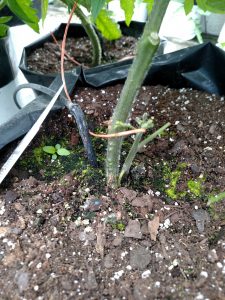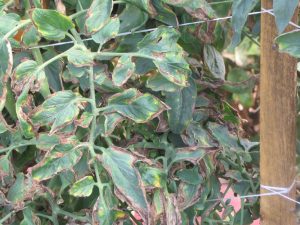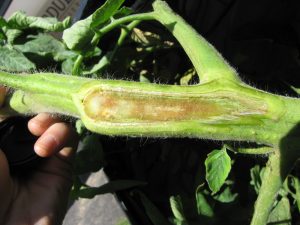Recently, this disease was observed in a greenhouse in Indiana. This article will serve as a review of this important disease.
The symptoms of bacterial canker vary considerably. In most cases, the edges of the leaves may turn yellow and/or brown. That is, the margins of the leaves may become chlorotic and/or necrotic (Figure 1). This symptom, which is sometimes known as ‘firing’, may be more common in a field situation than in a greenhouse. Tomato plants may wilt as a result of bacterial canker. The inside of the stem of affected plants may be discolored brown (Figure 2). The fruit may have bird’s-eye spots-this symptoms is more common in field outbreaks. In the greenhouse where this disease was recently observed, adventitious root development was observed on the stems of affected plants. That is, the stems may develop a ‘bumpy’ appearance where extra roots are starting to develop. However, this symptom may also develop from stresses other than bacterial canker (Figure 3).
The bacterium which causes bacterial canker of tomato may survive in seed, crop debris, volunteer tomatoes and equipment such as wooden stakes. The pathogen may spread from plant to plant by splashing. This is most likely during transplant production in the greenhouse. Once infected, tomato plants may continue to develop symptoms, which may give the appearance of spread in the field.

Figure 3: Occasionally, bacterial canker may cause a adventitious roots that appear as a ‘bumpiness’ on the stem of the tomato plant.
The most important factor in managing bacterial canker of tomato is to avoid seed contaminated with the pathogen or transplants that have symptoms. Heat treatment of seed to reduce contamination is possible; see the Midwest Vegetable Production Guide for Commercial Growers 2016. Use only new or sterilized planting stakes, transplant trays and other planting equipment. The use of copper and mancozeb products for management of bacterial canker of tomato is more effective in greenhouse transplant production than in the field.
Bacterial canker of tomato can become a very serious disease. If you believe that your tomatoes may suffer from bacterial canker, be sure to get an official diagnosis.

